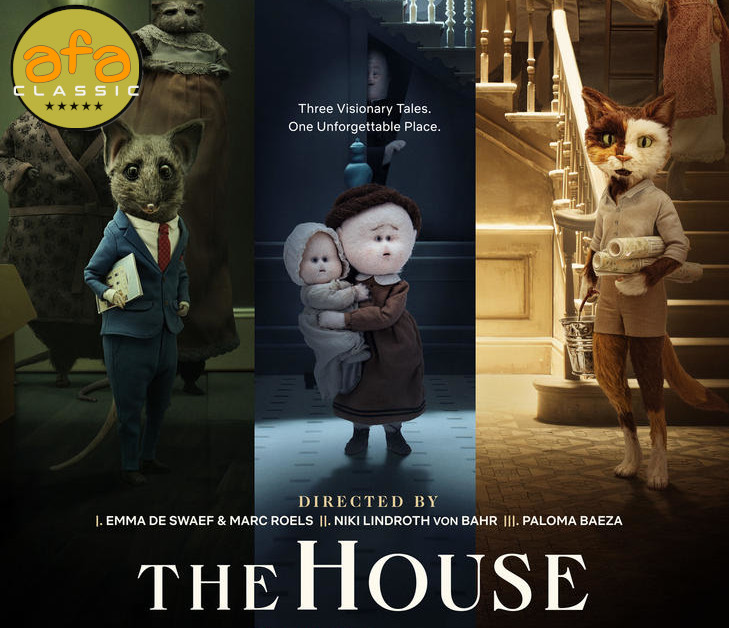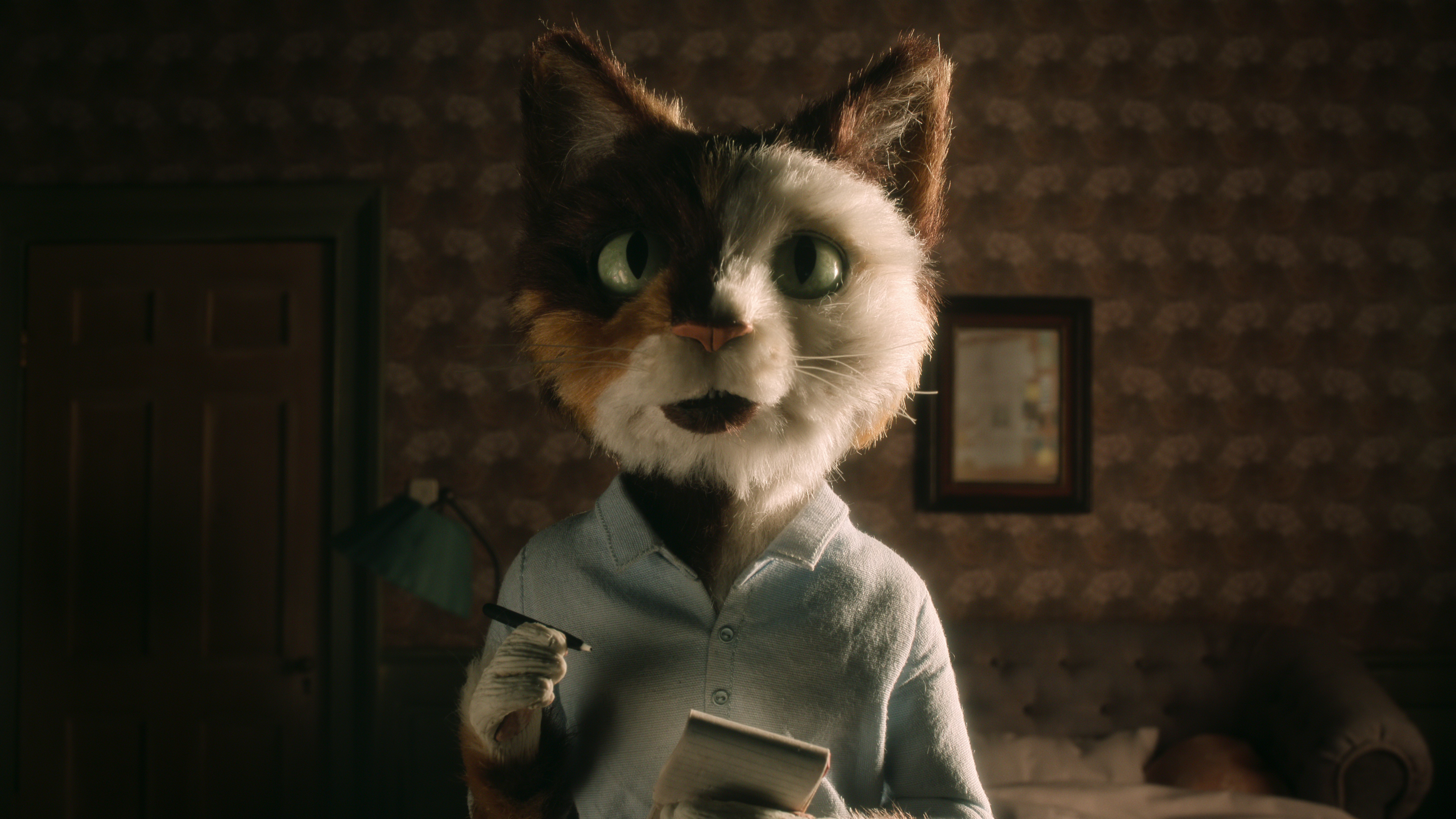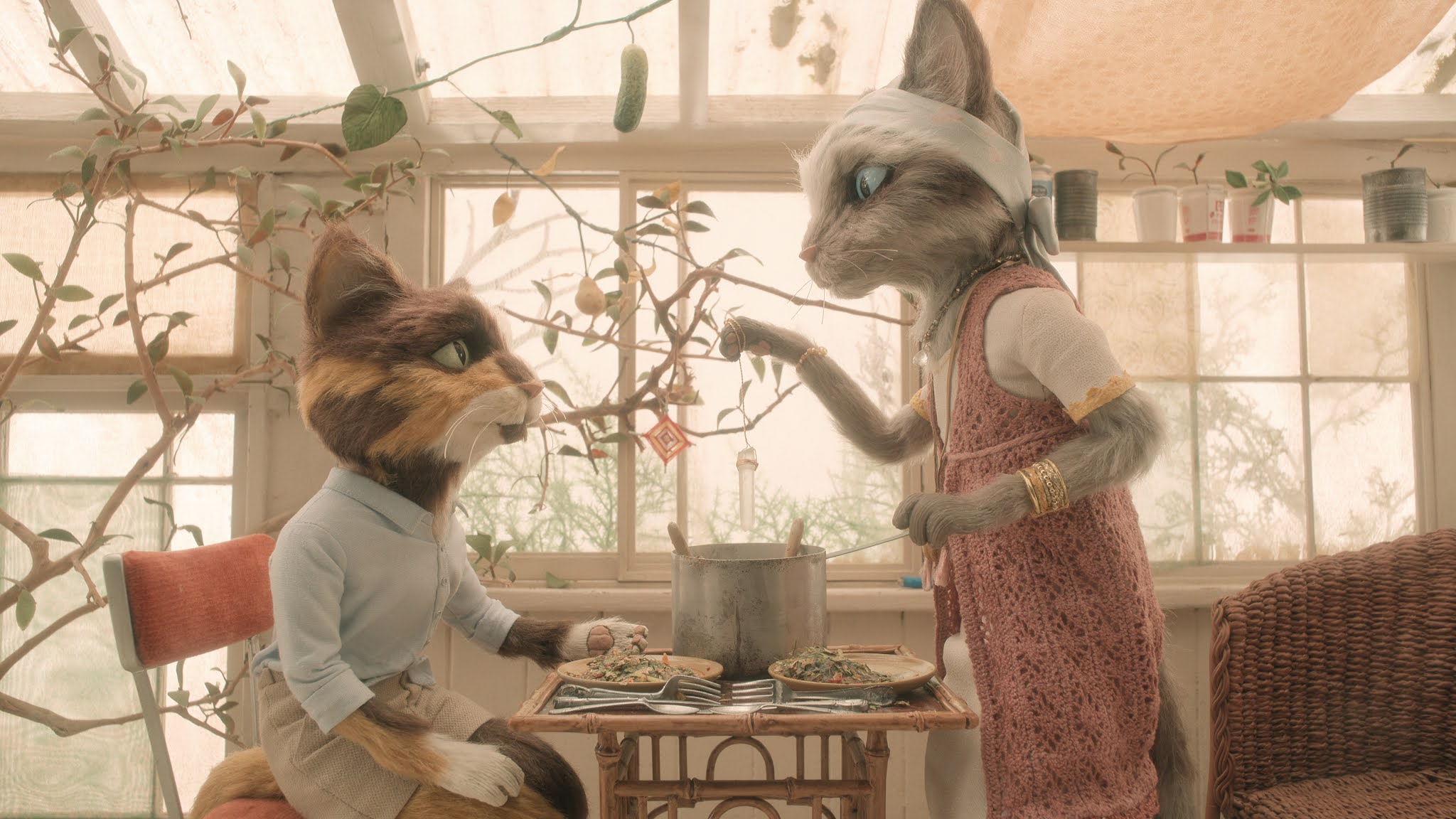The House (2022)
Stop-motion puppet animation is the one part of the medium that is essentially unchanged in its over a century of existence. 2D animation has moved from ink-and-paper and cels to being produced mainly digitally, and CG animation has consistently evolved over the years. Although there have been advancements with techniques such as 3D printing and CG elements the technique is fundamentally unchanged. The animation is produced in exactly the same way as it always has been.
The House is a stop-motion adult animated anthology produced by London's Nexus Studios for Netflix. It consists of three separate stories, each running for around 30 minutes, with each directed by some of Europe's most acclaimed independent stop-motion animators. Chapter one is directed by Belgium's Emma De Swaef and Marc James Roels (directors of the Annie nominated This Magnificent Cake), Chapter two comes from Swedish filmmaker Nikki Lindroth von Bahr (director of the Annecy Cristal winning The Burden) and Chapter Three comes from the UK's Paloma Baeza, director of the BAFTA-winning Poles Apart). All three segments are written by Irish writer Enda Walsh.
Although it has previously been described as a mini-series or special, Netflix presents The House as a single feature, which means that the producers presumably intend for it to be viewed all at once.
The connection between the three films is the location of the house itself, an impressive structure that probably qualifies as a mansion. But there are so many other variations between the different stories that it wouldn't be right to assume that they take place within the same world. For a start, the first story features human characters, but the second and third chapters both feature casts of anthropomorphic animals. The reason for this doesn't seem to be anything else than the fact they are each individual filmmaker's style. Look back at each director's filmography and you'll see their segment is consistent in style with all their past films.
With that said, this isn't one of those animated anthologies with styles that radically vary between its segments. The fact that Walsh scripted all three means there is a consistency in the tone, even if there are elements in each that reflect their director's style.
Also consistent throughout is the quality of the animation and puppet making. The latter comes from the peerless Mackinnon and Saunders who started work at beloved UK studio Cosgrove Hall and were later responsible for producing the models for Fantastic Mr Fox, The Corpse Bride, The Clangers (2015) and more. The sets are exquisitely detailed, making the house feel like a real place you could go visit.
The animation is smooth and the motion is naturalistic. There's none of the cartoonish exaggeration found in other stop-motion studios' works. In technical terms, this is much closer to Anomalisa than it is to Aardman.
The first segment takes place in the 1800s and is an origin story for the House itself. A poor Victorian family, who are looked down on by their richer relatives are approached by a mysterious figure who offers to build the family a house "as a gift". You might have already guessed that there's a catch, and once they move in, sure enough, strange things start happening.
Of all the stories, this is probably the one that makes the most use of the house itself. The house is brilliantly built, inside and out in all three parts, but the first chapter seems to spend longer exploring. With the story primarily told through the eyes of the family's oldest daughter, nine-year-old Mabel, it brilliantly captures the creepy feeling an unknown building can give you when you are a child. Wandering the rooms and corridors alone or along with her baby sister, it recalls numerous haunted/creepy house movies, and mines similar primal feelings played on in Stanley Kubrick's classically chilling The Shining.
There is also a sense that the house is always changing around Mabel, to the point that she becomes lost in her own home. A terrifying thought for anyone, let alone a small child.

|
De Swaef and Roel's style features distinctive doll-like character designs, with tiny beady eyes peering out of otherwise blank faces. Of all the chapters, it has the creepiest feel overall, with the sense of dread and the feeling that something just isn't right gradually building up to a sinister crescendo. Stop-motion is uniquely equipped to create creepiness, as it skirts the edges of the uncanny valley in a way that hand-drawn animation does not. Indeed, there are viewers who find all stop-motion to be unsettling in this way. The House probably is not going to change that.
Chapter two is an immediate change of pace. This time, the house is now in the middle of the city, surrounded by other buildings. Familiar imagery seems to place it in modern-day Britain, although in this case, Lindroth von Bahr's world is populated by anthropomorphic rats and mice. The story features a lone developer who is renovating the house in anticipation of selling it. For some time, he is the only character on screen, with the occasional one-sided phone conversation with unknown voices. Eventually, he holds an open house for potential buyers. Two of the guests- a very strange couple- promptly make themselves at home and refuse to leave.
This part feels more obviously comedic for the first part but it too takes a bizarre and disturbing turn. This chapter also features the film's one song-and-dance number, which is brilliantly choreographed and totally unexpected.
The third and final chapter is different again, with Baeza's world populated by talking cats. In this story, this time set in the near future, the house stands alone on a tiny patch of land, surrounded by water on all sides. The house is run down and a shadow of its former self. A young landlady named Rosa refuses to leave, although her only remaining tenants- sweet slacker Elias and dippy hippy Jen- are too broke to pay the rent. But Rosa is ultimately too kind-hearted to kick them out. The sudden arrival of Jen's eccentric boyfriend Cosmos soon throws Rosa's life even more of course.
Of the three chapters, it's definitely the lightest tonally. It has some mildly creepy parts, but otherwise, it's more of a magical realist fantasy and not as disturbing or downright weird as the other segments. Anthologies can be hit and miss, but there is no weak link here.
Although Baeza is the only one of the four directors to come from the UK, and the scripts are written by an Irishman, The House does somehow have a distinctly British feel. Much of this could perhaps be put down to the talented cast, which consists of top UK talent, established names such as Helena Bonham Carter, Paul Kaye, Susan Wakoma, Miranda Richardson, Stephanie Cole and Matthew Goode.
Special mention must go to the ever-brilliant Mark Heap (Spaced, Friday Night Dinner) who voices the architect's creepily polite representative in the first chapter with the same gusto as his on-screen performances. Voicing the developer in the second chapter, Brit-pop legend and occasional actor Jarvis Cocker (lead singer of 90s band Pulp) is a bit of a revelation, following up a small cameo in Fantastic Mr Fox with his first lead role. Cocker also contributed the end-credits song.
The voice performances are very understated and naturalistic across the board, which suits the material well and compliments the subtle 'acting' of the animation itself perfectly.
When put up against the rest of Netflix's other adult animation, The House really stands alone. It doesn't rely on constant swearing, strong violence or sexual content, it's adultness instead is in its dark themes and occasional disturbing imagery. Similarly, the humour here is subtle and understated. It's blackly comic and surreal, don't get expecting the constant visual gags and puns of something from Aardman.
It's really quite something that this even exists. It feels decidedly uncommercial and it seems like it would be unlikely to be a big mainstream hit. Its main appeal is going to be to art animation aficionados, fans of everything creepy and cinephiles so the fact that it was made for Netflix is remarkable.
The House is certainly not going to be everyone's cup of tea. For some, its lack of obvious jokes and macabre tone will be a step too far- and if you can't stomach creepy crawlies it's really not going to be for you either.
However, there is no disputing the fact that this is visually a work of art. In the hands of some of stop-motion animation's most talented directors, some of the world's finest model-makers and set builders have created some of the most impressive work the medium has ever seen. It's full of memorable imagery that will stick with you long after the credits have rolled and some really surreal scenes.
In this time of mega-franchises, sprawling cinematic universes, reboots and sequels, there is something incredibly refreshing about The House, something that seemingly exists merely for arts' sake. With luck, it will encourage the audience to seek out the director's prior works. If you're growing tired of glossy American animation or you've had your fill of anime, Nexus Studio's masterpiece will introduce you to a whole new frontier in animation.
★★★★★
















_1.47.1.tiff)













